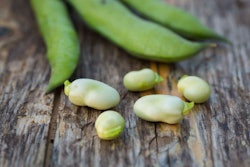
Grains that graced the tables of Babylonian and Mayan kings now appear in dog foods and treats, as formulators continue searching for novel pet food ingredients. Several of those ancient grains have been featured in Petfood Industry’s Ingredient Issues column. Yet more ancient grains, and how to use them safely and healthily in pet food, will be explored at the Petfood R&D Showcase: Going with the Grain.
1. Chia
Made famous by plant pets sold via infomercials, chia has value as a food for other, more mobile pets and their owners. Long before chia was a kitschy decoration, the people of what is now Guatemala and Mexico domesticated chia for its seeds. While still popular among Mayans and others in its home region, chia seed now appears worldwide in foods for people and pets with marketers touting it as a superfood.
Those superfood claims may be justified. Ancient grain chia seeds contains 19 to 26 percent protein, according to Greg Aldrich, PhD, Kansas State University professor of grain science and Petfood Industry columnist. The seeds are gluten-free, but do contain healthy omega-3 fatty acids and insoluble fiber.
2. Malt and sprouted grains
Malted barley, or malt, and other sprouted grains also have an ancient history and nutritious present. Malt has improved nutritional value over unsprouted barley, and is the main ingredient in beer, as the Sumerians and Babylonians were well aware. Modern day pets can get some of the same nutritional benefits from malt as King Hammurabi, without the intoxication.
Malt and other sprouted grains are produced by soaking the seeds until they germinate. That allows enzymes in the seeds to start breaking down stored sugars. Other physiological processes also may make nutrients in the seed more available for digestion. By killing the newborn plants, people and pets can halt the seeds growth while it is sweet and nutritious, but still capable of being processed like conventional seeds.
In pet foods, the sprouting process can help moderate the glycemic index and increase the availability of minerals and vitamins, while boosting shelf-life, flavor and sensory qualities of the food, according to Aldrich.
3. Wheat varieties
While wheat may not seem too exotic, Egyptian pharoahs didn’t eat bread made from the same wheat variety as modern supermarket white bread loafs. Like the pyramids, the wheat eaten by those ancient Egyptian god-kings still stands. That ancient grain is known as kamut wheat, and along with einkorn, emmer and spelt wheat, it could provide an alternative grain for pet food makers, according to Aldrich, despite a lack of research on ancient grains of wheat in pet food.
Petfood R&D Showcase: Going with the Grain
Pet food professionals can learn more about whole and ancient grains as novel pet food ingredients at Petfood Industry’s inaugural Petfood R&D Showcase: Going with the Grain. The event, which will take place October 10–12, 2017, will be held at Kansas State University (KSU) in Manhattan, Kansas, USA, and will include interactive labs and networking events hosted by pet food industry experts.


















